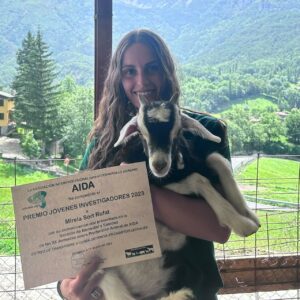– by G. Caja and A. Elhadi (UAB)

The European regulation for animal transport (EC 1/2005) indicates the requirements to be met according to species and conditions during long journeys (8-14 h). A range of temperatures (5-30 ± 5ºC) and minimum spaces are recommended according to the age and weight of the animals. For small lambs (>1 week and <20 kg), the space should be >0.2 m2/head (>0.010 m2/kgBW), but it is not known if this is adequate for suckling lambs travelling to abattoir to be slaughtered as “lechal” (30-45 d and 10-14 kgBW). Moreover, the regulation does not include recommendations for suckling goat kids, also slaughtered as “lechal” at light weights (30-60 d and 9-12 kgBW).
More than 3 million of lambs and kids of these categories are travelling to be slaughtered every year only in Spain but the “lechal” (milk fed) category is also typical of other Mediterranean countries.
For this reason, two experiments were carried out in the UAB in Spain with the aim of evaluating the impact of transport density on several stress indicators of light suckling kids and lambs transported over short journeys.
In the 1st experiment, 25 suckling goat kids (9.5 ± 0.4 kg BW, Murciano-Granadina breed) were used to evaluate the effects of 2 space densities for road transport over a short journey (2 h). Space densities for kids were: low (0.018 m2/kgBW; n = 10) and high (0.013 m2/kgBW; n = 15).
In the 2nd experiment, 20 lambs (13.9 ± 0.4 kg BW) of 2 breeds (Manchega; n = 10; Lacaune; n =10) were used to evaluate the effects of 2 space densities for a similar road transport over a short journey (2 h). Densities were: low (0.016 m2/kgBW; n = 8) and high (0.011 m2/kgBW; n = 12).
In both experiments, the trip was done on national roads at moderate speed using a trailer (1.8×1.0×1.3m; 2 floors and 4 compartments of 0.9 m2; Photo 1), equipped with sensors (temperature, humidity, sound and acceleration). A second accelerometer was placed in the driver’s cabin. Animals were weighed, temperature measured, and blood sampled at h 0 (uploading), h 2 (downloading) and h 24 (resting) from departure. Only Manchega lambs were slaughtered after arrival and their carcasses evaluated.
Acceleration peaks in the z-axis during transport were much higher in the trailer than in the cabin (11.8 vs. 1.5 g; Figure 2). Similarly, high noise peaks were recorded in the trailer (volume >500 dB and frequency >1400 Hz) which should be considered as stressful.

Weight of goat kids decreased during transport and recovered after resting. A non-significant weight loss was detected in the lambs after transport, without differences by breed, sex or transport density. Despite the mild ambient conditions during the journey (21ºC and 57%RH, on average), rectal temperature decreased during transport, which was ‒0.2ºC in the goat kids, and greater in the Lacaune vs. Manchega lambs (‒0.68 vs. ‒0.26ºC; respectively) agreeing their fleece traits, but without effect of density. All metabolic indicators increased by effect of transport, which indicated a situation of metabolic stress aggravated by cold conditions (12% of the kids showed shivering at arrival). High density during transport only increased serum creatine kinase (71%) and tended to increase lactate dehydrogenase in the kids. However, lactate dehydrogenase increased in the high-density lambs (+14%), without other significant effects. Lamb carcasses of the slaughtered Manchega lambs differed in color, which was darker in the low density lambs. In conclusion, space densities of 0.015 and 0.010 m2/kgBW, respectively for suckling goat kids and lambs, seem to be adequate for short journey transport. Nevertheless, relevant deficiencies in temperature, noise and vibration were detected when officially approved trailers for lamb and kids transport, were used.
Finally, closed trailers, with regulated ventilation and temperature, and reduced noise conditions, and with efficient shock absorbers, are recommended to improve transport in young kids and lambs.

These studies were presented in the XX Jornadas de Producción Animal in Aula Dei, Zaragoza (Spain) the past 13-14 of June:
– Sort, M., Elhadi, A., Costa, R., Recio, A., Salama, A. A. K. y Caja, G. 2023. Estrés de transporte a corta distancia en cabritos lechales. XX Jornadas AIDA, Book of proceedings, p. 4.
– Jesús, J. C., Elhadi, A., Costa, R., Recio, A., Salama, A. A. K. y Caja, G. 2023. Estrés de transporte a corta distancia en corderos lechales. XX Jornadas AIDA, Book of proceedings, p. 6.
The student Mireia Sort, who presented the kid’s study in the meeting, deserved one of the AIDA Prizes to Young Scientists (Figure 3).
